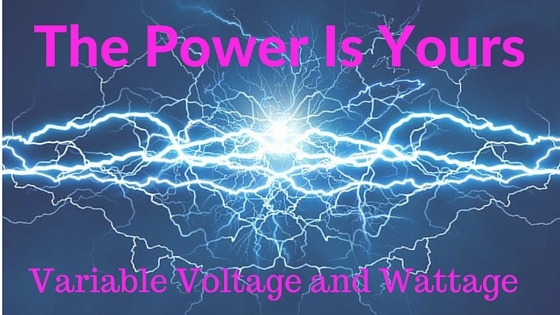
Variety, they say, is the spice of life, and this is true with ecigarette technology too. There are many different variations of batteries and tanks that can provide a diverse vaping experience. The most common options available are variable voltage, variable wattage and variable voltage/variable wattage devices, each of which allow novice vapers as well as experienced vapers to take more direct control of their hardware and to tune in the perfect balance of taste and cloud.
Variable Voltage
With variable voltage devices, the controls on the battery/mod allow the user to decide how much electricity they would like to flow to their atomizer. Changing the setting up and down will produce a different result, depending on a number of factors. For instance, the type or ejuice that you use or the blend of PG/VG that you prefer has an effect on how the juice is vaporized. Some have a slightly better taste at a higher voltage setting than others, where others taste better at a lower setting. This may be because of something as simple as orange doesn’t taste the best when hot. It may also be because an ejuice with higher VG doesn’t soak into your coil fast enough to give you the best flavor with each puff.
Variable voltage devices are popular as a first choice for many vapers who are starting to explore the different ways of modifying the way their ejuice is vaporized, and refining their vaping experience. Often these entry-level devices are partnered with lower powered tanks and high-resistance atomizers that can better handle the increased voltage levels without burning out too quickly. These mods also tend to offer vapers a modest battery capacity because devices using variable voltage do not require a ton of battery to do so. For one popular option, check out the eGo-C Twist 1000 mAh, which offers standard eGo and 510 threading to easily connect to most tanks.
Variable Wattage
A more recent feature of some ecigarettes is the variable wattage setting option. These devices tend to come with a larger battery, as wattage regulation can use more battery to get a more consistent setting. Mods with this feature have a chip that detects the ohm resistance of your atomizer and balances the voltage level to create a more constant heat. Unlike variable voltage that can get hotter and hotter with more use, variable wattage attempts to regulate the amount of voltage released based on the ohm resistance in hopes of keeping your vapor temperature in your desired range. It’s always best to remember more wattage equals more heat.
Once you’ve found the right balance of resistance and voltage by setting your wattage this setting will be the same every time you put that resistance coil on a device at that wattage setting. It is important to realize that, for example, setting your device to 80-watt on a coil reading 2.5 ohms will not vape the same as placing your device on 80 watts with a coil reading 0.5 ohms. Many people misunderstand the “cruise-control” nature of wattage. A wattage controlled device will adjust to produce vapor within an optimal temperature range as your coil changes ohm resistance during your vaping time. This however does not mean you can place drastically different coils on the same setting and expect the same results.
Cruise-control, as stated above, is the best way to describe this.
If you set your cruise-control to 55 mph, and you drive along a level road, your engine produces the same amount of power. This is like a coil being vaped that never changes ohm resistance while heat is applied (we won’t get into how that is never going to happen). Now you come to a hill, your car will make the proper adjustments to keep you at 55 mph. Now this is going to raise your RPMs, but in theory keep you at 55 mph. Your wattage chip will do the same. Just because as your coil heats up, and the ohm resistance changes slightly (or there is a hill in your path) doesn’t mean your wattage control will stop working. Now, this does not mean you can throw whatever coil you feel like at that wattage setting and expect the same hit. That is like saying a V6 and a V10 motor would hit the same RPMs while going up the same hill at the same speed. It’s just not true. Also important to note: wattage chips come in two main types (gas and diesel if you will). These types are Mean and RMS. They will do a similar job in a slightly different way, but that’s for another day.
It’s important to note, that though variable wattage does a better job of avoiding this, both variable voltage and variable wattage devices can lead to overheating, particularly with heavy vapers and high settings. Overheating doesn’t happen at one particular temperature, but rather at a point where the wicking material can no longer bring juice in fast enough for the current heat. This results in the burning of the wicking material, and a terrible taste. This is where an even newer technology – temperature-controlled vaping – comes in. With this technology, users can balance their optimal level with a specific temperature setting which helps prevent overheating and dry hits. Learn more about this tech by reading our recent blog post, or stop into one of our Las Vegas locations to see a demonstration – or any of our other great products – for yourself.
